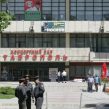
Ethnic Russians Leave Stavropol Creating Regional Security Vacuum
Publication: Eurasia Daily Monitor Volume: 10 Issue: 55
By:

At the beginning of 2013, several trials of suspected militants concluded in Stavropol region. Some observers assert that Islamic extremism has found a suitable breeding ground in the eastern part of Stavropol region because of its depressed economy and influx of ethnic Dagestanis from neighboring Dagestan. On February 28, three people from the group led by Rafael Ismailov were sentenced to lengthy prison sentences for three terrorist attacks that used cars loaded with explosives. Ismailov had reportedly declared himself the emir of the Vilayet Nogai Steppe, more commonly known as the Stavropol region. Government forces gunned down Ismailov and his close associate Tamerlan Gajiev on the highway that connects the cities of Budyonnovsk and Achikulak in October 2010. Meanwhile, on March 7, Ibragim Akakov was sentenced to a lengthy prison term for participating in the extremist group led by Eldar Bitaev. Bitaev’s group planned bomb attacks in Stavropol region’s transportation hub, the city of Mineralnye Vody. Most members of the group were killed in the police special operation in April 2012 (https://kavpolit.com/vzryv-s-vostoka/).
All of the people involved in the attempted terrorist attacks came from the eastern parts of Stavropol region, in particular Neftekumsky district. Most of them were apparently ethnic Nogais, a Turkic-speaking people native to Stavropol region, Dagestan, Chechnya and Karachaevo-Cherkessia. They were all under the influence of the Dagestani jamaat. It is also interesting that even though the members of the jamaat came from the eastern part of Stavropol region, they plotted attacks in the southern part of the region—Pyatigorsk, Mineralnye Vody, Zheleznovodsk and other cities that comprise a sub-region of Kavkazskie Mineralnye Vody within Stavropol region.
In addition, the striking common feature of these groups is that none of them achieved much success in carrying out their attacks. This may have two possible explanations: either the groups were amateurish and did not really pose much danger, or the groups were unsuccessful because they lacked the same amount of support from the local population in predominately Russian-speaking Stavropol region as militants in the ethnically non-Russian republics of the North Caucasus.
Neftekumsky district is larger geographically than Ingushetia, but its population is only about 70,000. Ethnic Nogais comprise about 17 percent of the district’s population. The district has a long border with Dagestan, which is why a large number of Dagestanis cross into the district and settle there. The predominant economic activities in Neftekumsky district are related to agriculture. Rosneft has an oil extraction plant in the district, but the oil deposits have apparently declined and the company faces a reduction of its activities. Norwegian Statoil reportedly had plans to invest its new technologies to make the extraction of oil profitable, but the talks about this venture stalled over time and their prospects are unknown at the moment (https://kavpolit.com/vzryv-s-vostoka/).
Stavropol Agricultural University demographer Yuri Yefimov told Svobodnaya Pressa website that the demographic shift in Stavropol region, and specifically in its eastern districts, is complex. Ethnic Russians are leaving the region not only because of “pressure from Caucasians,” but because of a lack of opportunities. The government, according to Yefimov, is not interested in protecting ethnic Russians in the eastern parts of Stavropol region. “Russians are mostly used to stability, to life according to the law,” Yefimov said. “But now there are no honest forms of earning proper income [in the eastern part of Stavropol].” The Russian demographer appeared to suggest that by “stability” and “honest” income, he meant government employment or comparable private employment (https://svpressa.ru/politic/article/57656/).
It is clear that the Russian government—and, for that matter, the Russian people—are worried about the influx of non-Russians into Stavropol region and the decrease in the size of the ethnic Russian population living there. However, there are few legal mechanisms available to the Russian authorities to stop the inflow of Dagestanis, who are Russian citizens, into an adjacent part of Russia. After all, Dagestanis have the same legal rights as ethnic Russians—at least on paper. The government supposedly has no legitimate authority to support one group of the population, especially the majority, at the expense of other groups. However, this is just what is going on in Stavropol region. Regional officials set up Cossack groups that patrol the streets and work with the local police. There are 142 Cossack groups in Stavropol region that carry out patrols with the consent of authorities. Most of these groups operate in the border towns with Dagestan and Chechnya. Even though the Cossack groups have had semi-official status with limited funding from the government, the authorities are now proposing to provide state funds to officially support the Cossack groups (https://kavpolit.com/kazachij-bunt-grozit-stavropolyu/).
In March, a Stavropol court ruled that Muslim girls could not attend schools wearing the hijab, since it undermines the secular character of the Russian state (https://wordyou.ru/v-rossii/pravosudie-stavropolya-kak-xochet-tak-i-imeet-pravo.html?fb_comment_id=fbc_155074917988590_352296_155196537976428#f248337858). Moreover, prosecutors in Stavropol region have adopted a proactive position, and in September 2012 obliged the schools to report on their pupils who wear religion-related clothing (https://kavpolit.com/pravdoiskateli/). Activists in Stavropol region wrote another petition to transfer Stavropol region from the North Caucasus Federal District to the Southern Federal District and introduce a “special migration regime” that would apparently preclude the arrival of North Caucasus natives to the Stavropol region (https://nekavkaz.org).
The tensions in Stavropol show that the project of creating a unified “civil Russian nation” is failing at this point. Instead, both the Russian government and the ethnic Russian public appear inclined to adopt a model of an imperial Russian nation with a hierarchy of ethnic groups, with the ethnic Russians at the top. This model is already causing tensions of its own and will continue to do so for the foreseeable future, as both ethnic Russians and ethnic Caucasians are unlikely to be satisfied with the current status quo.




